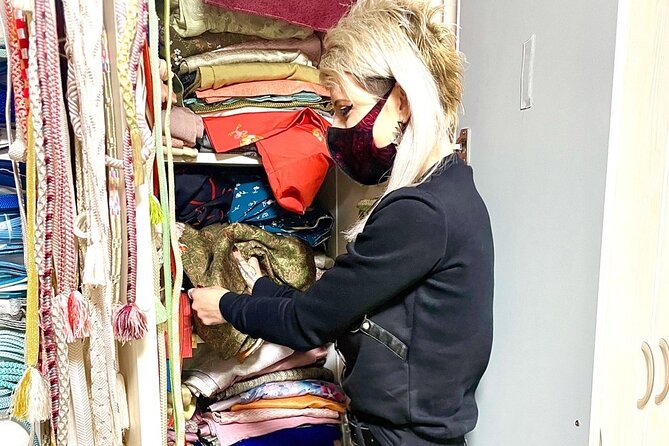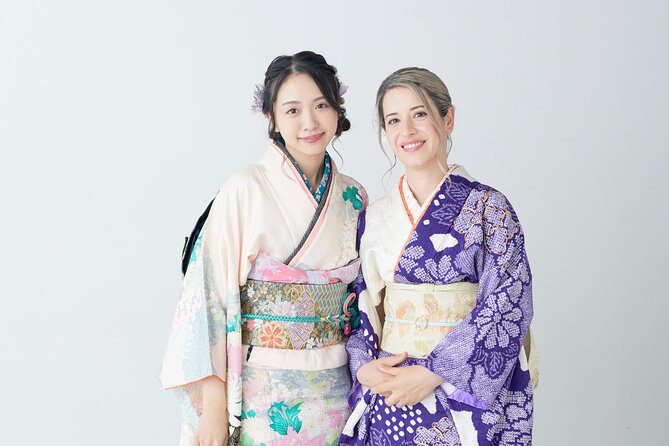In the realm of Japanese culture, creating a kimono is like painting a canvas with threads, weaving together history, tradition, and elegance.
‘Let’s Make a Kimono! (Kimono Is a Gift for You)’ beckons individuals to step into the world of this iconic garment, promising a hands-on journey through the intricate process of dressing in a kimono.
From selecting the perfect fabric to mastering the art of kimono accessories, participants are immersed in a world where every fold and knot tells a story.
This experience offers a glimpse into the meticulous craft of kimono-making, inviting all to explore the beauty and depth of Japanese sartorial heritage.
Key Points

- Choose the right kimono style to match the season and occasion, reflecting personal preferences.
- Select accessories like obi and sandals to complement the kimono, enhancing elegance.
- Care for your kimono diligently through proper cleaning, storage, and maintenance for longevity.
- Pay attention to fabric selection, harmonizing colors and patterns to create visually appealing ensembles.
Traditional Kimono Making Process

Exploring the intricate art of crafting a traditional kimono involves a meticulous process that showcases centuries-old techniques and cultural significance. Kimono design is a reflection of Japan’s rich history, with each motif, color, and fabric choice holding symbolic meaning.
Traditionally, kimono making begins with selecting the appropriate fabric, often silk, and dyeing it using intricate methods such as shibori or yuzen. The designs are carefully planned to convey specific messages or themes, drawing inspiration from nature, literature, or seasonal events. Skilled artisans then cut the fabric and sew it together using precise stitches to create the elegant garment.
The history of kimono making is deeply rooted in Japanese tradition, with each step of the process honoring the craft’s heritage.
Choosing the Right Kimono Style
To choose the right kimono style, consider the occasion, your body shape, and personal preferences. When selecting a kimono, keep in mind the following:
-
Kimono Color:
The color of the kimono should match the season and the event you’re attending. Bright, vibrant colors like red and pink are suitable for spring and summer, while deeper tones like navy and burgundy are perfect for fall and winter occasions. -
Kimono Season:
Different kimono styles are designed to be worn during specific seasons. Lighter fabrics such as cotton and linen are ideal for warmer months, while silk and wool kimonos provide warmth during colder seasons. -
Personal Preferences:
Ultimately, choose a kimono style that makes you feel comfortable and confident. Personal taste plays a significant role in selecting the perfect kimono for any occasion.
Understanding Kimono Accessories

When selecting a kimono style, understanding the accompanying accessories such as obi, obiage, obijime, obi pillow, Japanese sandals, and tabi enhances the overall traditional attire experience.
These accessories have deep roots in kimono history and play a significant role in conveying kimono symbolism. The obi, a sash worn around the waist, not only secures the kimono but also adds elegance to the outfit.
Similarly, the obiage and obijime are used to tie the obi in place, with each knot style representing different meanings. The obi pillow helps maintain the obi’s shape and prevent creases.
Japanese sandals and tabi complete the ensemble, emphasizing the cultural significance and meticulous attention to detail in traditional Japanese attire.
Kimono Fabric Selection Tips

Selecting the perfect kimono fabric involves considering factors such as texture, color, and pattern to create a harmonious and visually appealing traditional garment. When choosing kimono fabric, one must keep in mind the following tips:
-
Silk vs. Cotton: Silk is luxurious, smooth, and drapes elegantly, making it ideal for formal occasions. Cotton, on the other hand, is breathable and more casual, suitable for everyday wear or warmer weather.
-
Color Coordination: Harmonizing colors is crucial in kimono fabric selection. Traditional kimono often feature a main color with complementary or contrasting hues. Understanding color theory can help in creating a visually striking ensemble.
-
Pattern Selection: Patterns on kimono fabrics can range from intricate floral designs to geometric shapes. Choosing a pattern that complements the wearer’s body shape and personal style is essential for a well-balanced kimono ensemble.
Step-by-Step Kimono Dressing Guide
Considering the fabric selected for the kimono, the next step involves mastering the art of dressing in this traditional Japanese garment with a detailed step-by-step guide. When it comes to kimono dressing, understanding the intricate kimono tying techniques is essential. This process not only showcases the beauty of the garment but also reflects the rich history and culture of Japan.
| Step | Instructions |
|---|---|
| 1 | Put on undergarments |
| 2 | Slip into the kimono |
| 3 | Adjust the length and fold |
| 4 | Tie the obi securely |
Learning these steps will help one appreciate the elegance of the kimono and the significance behind each tying technique. Embrace the tradition and style of the kimono with this guide.
Caring for Your Kimono
To maintain the quality and longevity of your kimono, proper care and attention to detail are crucial. Kimono maintenance is essential to preserve its beauty and fabric. Here are some tips for caring for your kimono:
-
Cleaning: Dry cleaning is often recommended for kimono to prevent damage to delicate fabrics and intricate designs.
-
Avoiding Sunlight: Direct sunlight can cause colors to fade, so it’s best to store your kimono in a cool, dark place.
-
Storage Tips: Keep your kimono in a breathable garment bag or folded neatly to prevent creasing and dust accumulation.
Kimono Etiquette Dos and Don’ts
Proper etiquette when wearing a kimono is key to respecting Japanese traditions and cultural norms. Kimono etiquette holds significant cultural significance in Japan.
When wearing a kimono, one should be mindful of certain dos and don’ts. Firstly, ensure that the left side of the kimono wraps over the right side, as the opposite signifies dressing for the deceased. Plus, when sitting, tuck the kimono under the knees, and remember not to cross the legs.
Avoid wearing bright and flashy obi belts during formal events, and opt for more subdued colors. When visiting shrines or temples, it’s respectful to wear a subdued kimono.
Showcasing Your Kimono Style
When showcasing your kimono style, focus on incorporating traditional accessories to enhance your overall look authentically. To elevate your kimono fashion, consider these styling tips:
-
Obi: Choose a vibrant obi that complements the color of your kimono. The obi serves as a focal point and can add a pop of color or intricate patterns to your ensemble.
-
Obijime: Use an obijime to secure the obi in place and add a touch of elegance. This decorative cord comes in various styles and colors, allowing you to personalize your look.
-
Obiage: Complete your kimono style with an obiage, a decorative sash that ties around the obi. Opt for a contrasting or matching obiage to add a polished finish to your outfit.
Common questions
Can Children Participate in the Kimono Making Activity?
Children can actively participate in the kimono making activity with parental involvement. It fosters creative expression, skill development, and cultural appreciation. This engaging experience allows kids to learn and create their own unique piece.
Is There a Specific Age Limit for Participants in the Kimono Making Experience?
The age limit for the kimono making experience allows for children’s participation. Young participants can engage in this creative activity, learning about traditional Japanese attire while having fun. The experience caters to a range of ages.
Are There Any Restrictions on the Sizes Available for the Kimono and Accessories?
Size options for the kimono and accessories are limited to ensure a personalized fit. Material choices vary, typically including silk for traditional garments. Participants can expect tailored options that enhance the experience and authenticity of creating their unique kimono ensemble.
Can Participants Choose the Color and Design of the Kimono They Will Be Making?
Participants can choose the color and design of the kimono they’re making. Fabric choices and embellishment ideas are available for customization. The activity offers a range of options to personalize the kimono to suit individual preferences.
Is There a Time Limit for How Long the Kimono Making Process Will Take?
The kimono making process typically takes several hours, allowing participants to enjoy traditional techniques while understanding the cultural significance. Modern adaptations may streamline the process without compromising the artistry and authenticity of this time-honored craft.
Last Words
To sum it up, ‘Let’s Make a Kimono! (Kimono Is a Gift for You)’ offers a truly immersive and unforgettable experience for those looking to explore the world of Japanese culture and tradition.
From the intricate process of creating a traditional kimono ensemble to learning about the different styles and accessories, participants are sure to walk away with a newfound appreciation for this iconic garment.
Don’t miss out on this opportunity to showcase your kimono style and embrace the beauty of Japanese fashion.

